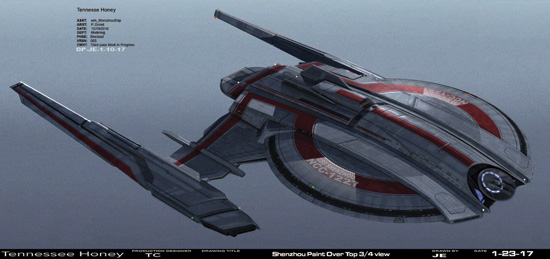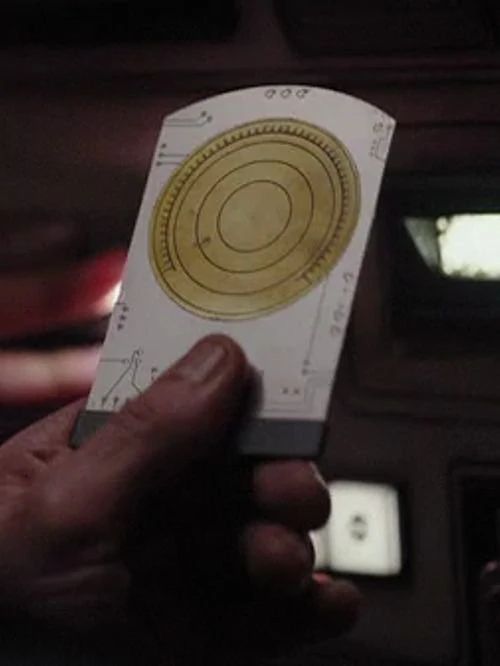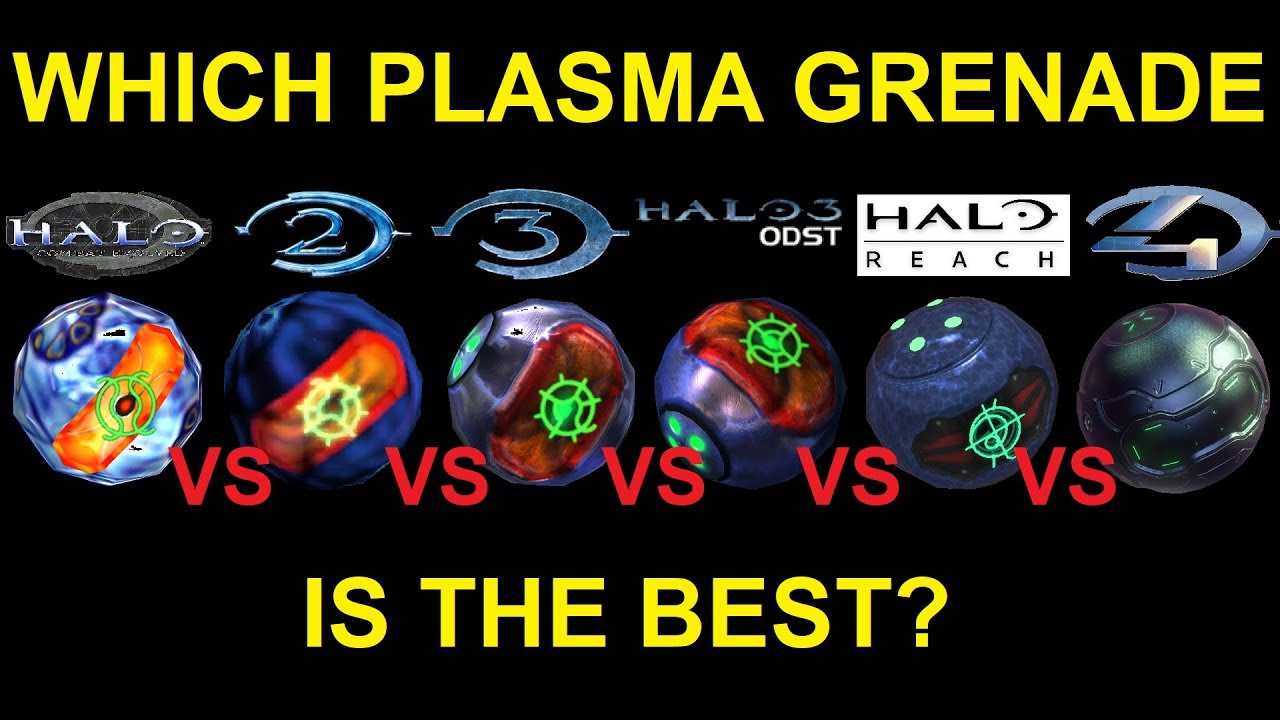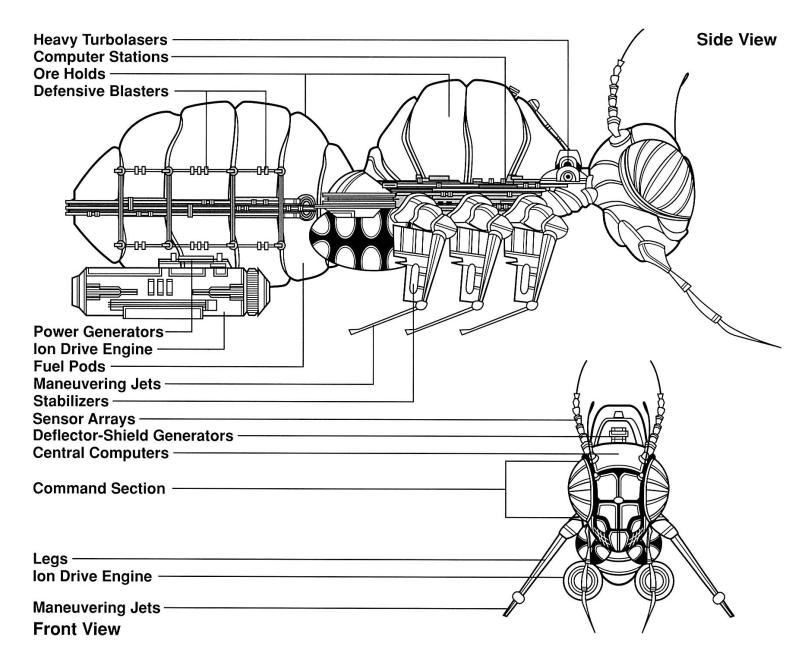 WALKER-CLASS DEEP SPACE EXPLORER
Craft: Walker-class DSE
Model: Unity Stardrive Corp Walker-class deep space explorer
Affiliation: Independent
Type: Exploration vessel
Scale: Capital
Dimensions:
-Length: 250m
Skill: Capital ship piloting (Walker-class DSE)
Crew: 77
-Gunners: 15
-Skeleton: 15/+5, 5/+10
Crew Skill: Capital ship gunnery 5D, capital ship piloting 5D+2, capital ship shields 4D+2, sensors 6D, starship gunnery 5D+1
Passengers: 100 (science staff)
Cargo Capacity: 20,000 metric tons
Consumables: 2 years
Cost: 12,000,000 (new); 7,000,000 (used)
Hyperdrive Multiplier: x2
Hyperdrive Backup: x18
Nav Computer: Yes
Maneuverability: 3D
Speed:
-Space: 4
-Atmosphere: 280; 800kmh
Hull: 3D
Defenses:
-Shields: 1D
Sensors:
-Passive: 20/1D
-Scan: 40/1D+2
-Search: 80/2D
-Focus: 3/3D
CRAFT CAPACITY:
-4 Starfighters or Light Shuttles
-OR 2 Medium Shuttles
-OR 1 Light Feighter
-2 Worker Pods
WEAPONS:
8 Laser Cannons
Location: Mounted dorsal & ventral upper hull
Fire Arc: Turret
Crew: 1 (8)
Skill: Starship gunnery
Scale: Starfighter
Fire Control: 2D
Range:
-Space: 1-3/12/25
-Atmosphere: 100-300/1.2/2.5km
Damage: 2D
Rate Of Fire: 1
2 Concussion Missile Launchers
Location: Mounted in front sides of lower hull
Fire Arc: Front
Crew: 3 (2)
Skill: Capital ship gunnery
Scale: Capital
Fire Control: 3D
Range:
-Space: 2-10/25/50
-Atmosphere: 200-1/2.5/5km
Damage: 7D
Ammo: 10 each (20 total)
Rate Of Fire: 1
Special: See below
Tractor Beam
Location: Mounted in aft hull near shuttle bay
Fire Arc: Back
Crew: 1
Skill: Capital ship gunnery
Scale: Capital
Fire Control: 3D
Range:
-Space: 1-3/10/20
-Atmosphere: 100-300/1/2km
Damage: 4D
Rate Of Fire: 1
DESCRIPTION:
After the success of the McQuarrie-class Deep Space Explorer a century before its time, around 300 BBY, USC decided to try their luck again with the Walker-class DSE. In many ways it is a cut-down version of the McQuarrie, using many cost-saving measures to make the ship much more affordable, yet the ship still had the dependability and long-lasting durability that the McQuarrie had become known for. While some may argue about what the Walker-class lacks, many more cheer for what it's good at, reducing the needs that most capital ships require of their crews for ease of operations and functions, and allowing the crew more comfort on their long missions.
The Walker is listed as being longer than the McQuarrie, however this is deceiving. Most of the length is in the Walker's Add-On Pods, a similar cost-saving tech design used in the McQuarrie DSE. While these Add-On Pods are relatively longer, the main hull of the ship is much more compact than the McQuarrie was. The Walker requires less crew, and has less room for passengers and cargo, but makes up for this by being more spacious and roomy for the occupants who reside on the ship. The room for labs and the ability to alter these as needed is more restricted than the McQuarrie, and it is recommended that the crew have their desired labs set up before leaving on their missions. Due to this, while the ship has less cargo space, the Walker DSE can still carry an abundance of tools and supplies, and technically inclined crew may still be able to modify concussion missile to deliver warhead variants.
The ship has fewer weapons, but like the McQuarrie DSE, this is a product of the times, as weapons technology may not have been as powerful, and the need for more firepower died down since the time of the McQuarrie. Yet, the Walker can still pack a punch when required to do so. The Walker can be modified to carry more weapons, if you can find the room to install them.
LAYOUT
The Bridge
Unlike other USC starships where the bridge is in the top center of the saucer section, the Walker-class has its bridge located in the bottom center instead. This allows the command staff to use the bridge as an observation deck when in orbit of a planet, or similar positioning, to better observe their operations and events during their missions.
Labs, Workstations, and Other Facilities
The Walker-class DSEs are meant for long term distance and travel. To this end, they have consumables for up to two years, and much of their cargo space has been converted not only for passengers and their personal and scientific gear, but also many well stocked and equipped laboratories and technical workstations to allow them to do their research. Sometimes these labs have more than one scientist or technician making use of them for multiple projects, as this is still a starship with only so much available space to make use of. These labs can be used for almost any project, from xenozoology, microbiology, chemical and chemistry, stellar cartography, and various levels of quantum physics and astrophysics, among many others (however, changing their functions during mission and flight can be difficult, and is advised to be set up before leaving on missions. This is because, while the Walker has more comforts for the crew, it may not have the room of the McQuarrie for carrying anything and everything for these labs). These labs can also be converted and repurposed as desired. The other workstations are often for technicians that are not devoted scientists but engineers and techies who deal more with the hardware, ranging from physical labor with large machines and devices, labor with smaller, more fine-tuned and detailed machines, computer techs involved with both hardware and software, and even materials fabrication of practically any kind needed during long exploration missions using particle fabricator machines whose ancestors harkon back to devices once called "3D printers".
The particle fabricators are one of the must unsung yet important parts of the ship, as they can produce not only materials, but also specific shapes, of various sizes oncluding very large sizes, can combine multiple materials to make various types of compounds, and is essential for making any and all replacement parts the ship would ever need. There are several types of particle fabricators on board, most used for parts and components, though some have been set aside for producing common materials like clothes, and for producing foodstuffs. The food version is used rarely as the food is often criticized as not being as good as the real thing (though most foods in the Star Wars galaxy are probably synthetic anyway), however these are still aboard the ships due to the potential of stored consumables becoming corrupted through any number of possible means, and make a welcome alternative of food if and when the crew gets hungry enough. As these are called "particle fabricators", they can use raw materials of almost any kind to produce results, though the more work they have to put in converting raw materials into something else, the longer and harder they will have to work. For instance, using metal to produce other metals is relatively simple and takes little time, but taking raw ores and converting them takes more time, and taking non-metallic materials and converting them to produce metals could take over a day at best for simoke items, and many days for larger items, if they are kept simple like wrenches or hull plating. One reason the food fabricators are not used, aside from taste, is that the best raw materials used in them should be materials already used for foodstuffs, such as discarded food remnants and other waste, though the fabricator eliminates any form of contamination, and in fact can take any contamination in these wastes and completely convert it into an edible foodstuff in the process. It should also be noted that the fabricators deliver product and item results as good as the designs used in their computers, which can and usually is done by a technician who specializes in such design elements. Unfortunately, while food fabricators also work this way, there are rarely any technicians aboard who know how to "design food" and the food fabricators are left to use default factory installed food designs that are often bland at best. All of these facilities, computers, machinery, and various other equipemnt in both labs and storage are taken account in how much cargo space is taken up in the conversion of the McQuarrie class into an exploration vessel. The science and exploration labs tend to be displaced throughout the upper hull saucer section, while the techinical and engineering workstations tend to be in the lower hull section.
NOTE: The Walker class, due to design restrictions, carries only a single fabricator unit.
Shuttle Bay
The ship's shuttle bay is located in the aft of the lower hull. Though this is positioned between the ship's ion engines, the vessel's design and the common sense of any decent pilot is such that approach, embarking and disembarking is an easy and smooth process with very little danger. While the "craft capacity" above lists 4 starfighters or light shuttles, most often these explorer vessels have various craft that can carry 1-6 passengers plus cargo that are roughly the size of a starfighter, built less for combat with little-to-no weapons, but having better sensors than most starfighters their size usually would, though they may have comparative speed due to the need to evade hostile threats and environments. These can be used to expand the ship's sensor detecting capabilities, as well as allowing for closer inspection of odd things found in space, and even performing reconnaisance of derelicts in space or planetary atmospheres and geography. The listed medium transport shuttles are craft usually bigger than starfighters that can carry 1-12 passengers, long term away gear, various scientific equipment depending on mission and need, and perhaps even a light ground vehicle (1-4 passengers) or 2 (speeder bikes), and are often meant for survey, investigation and exploration teams that are leaving the ship and heading to the ground of a planet or into a derelict ship or space station, etc, and are intended for investigation and exploration teams that will be away for prolonged periods of time...."away teams".
GAME NOTES:
Hangar and Craft Capacity
Being a cut-down version of a McQuarrie DSE, this style of ship carries less extra craft (4 starfighters or light transports, or 2 medium transports, or 1 light freighter). "Light Transports" is for ships that are about the size of a starfighter, but not meant for combat, and could easily transport 4-6 people to and from a planet and 60 metric tons, plus 10 metric tons per passenger spot not occupied. Medium Transports count as x2 that of a starfighter or light transport, so they can carry 8-12 people and 120 metric tons plus 10 more per passenger spot not occupied. "Light Freighters" counts for ships around Millenium Falcon sized.
Cargo Capacity could also be converted for more hangar space.
S-Foil Pylons and Add-On Pods
While odd looking in the ship design, these additions to the hull increase the ship's overall speed, maneuverability, sensors, and shields. When these are damaged and destroyed, their removal decreases these traits and affects the ship's performance. The loss of a pod decreases Speed -1, Shields -1 pip, and Sensors decrease -5 Passive range, -10 Scan and Search ranges, -1 Focus Range, and -1 pip to bonus dice. The loss of an S-Foil pylon that these pods are mounted on decreases the ship's maneuverability by -1D. The loss of both pods and both S-Foil pylons reduces the ship's Speed to 2, Maneuverability to 1D, Shields to +1, and Sensors to Passive: 10/+1, Scan: 20/1D, Search: 60/1D+1, Focus: 1/2D+1.
Sensor Dish Add-On
While the McQuarrie had a Sensor Dish aftermarket add-on, the Walker never did have an official product produced to serve this purpose. Never the less, independent ship owner have tried, with varying degrees of success, to have custom Sensor Dishes made for the Walker-class and installed in the hull.
Concussion Missile Variants And Other Mods
Due to its scientific nature, technical minded individuals may want to attempt altering the Walker's concussion missiles for alternative effects. Possible alternatives to standard damage Concussion Missile warheads can include, but are not limited to: Ion or Mag-Pulse warheads that do ion damage; Plasma Warheads that deal damage directly to the shields (Shield Busters); Gamma Ray Warhead that deals damage directly to biological organisms, bypassing the hull, but only if the Shields are down, otherwise it has no effect. Scientists and technicians aboard these vessels can use the scientific and technological equipment aboard their well stocked and equipped exploration and science vessels to modify various concussion missiles to act as power disabling ion warheads, shield-busting plasma warheadsm etc, and up to GM discretion. While these make great examples of what can be achieved with a well stocked and equipped science and exploration vessel with a creative crew, often the sky is the limit with what can be achieved if/when the right tools and resources are available. However, due to the Walker's cost-effective nature and less expansive supplies and resources, these attempts may incur a +5 to the Difficulty rolls (DM discretion).
GAME DESIGN NOTES
This ship was pretty easy, taking the McQuarrie and making a reduced, more cost-effective verion of it. If the McQuarrie class was purchased by big mining companies to exploit vast swathes of uncharted space, but "could" be used as an exploration vessel, this would be closer to a covilian model or one that might be chosen by a group of scientists on a tighter budget.
Despite any limitations the ship may have (and honestly, by the stats it's less about being "limited" and more about having a more personal-sized ship that still has room for customization and mods), it still carries the Sensors of the McQuarrie class. If these ae considered weak by modern era Star Wars (around the time of the Galactic Empire and Rebel Alliance), they can easily be swapped out for a newer system or upgraded and improved. Actually, this is true for the whole ship. Despite its smaller size, the Walker has a lot of potential.
As listed above, 5 crew could run the ship at +10 Difficulty. However, this Difficulty can be reduced using automation systems.
HISTORY
History Recap - circa 400 BBY
Around 400 BBY, a galactic recession on the starship market leading to cutbacks and downsizing from Kuat Drive Yards and its subsidiaries, among other companies involved in the manufacture and sales of starships, notably in the Core Worlds region, resulted in several previous employees pulling strings and taking advantage of several factors that led to the creation of Unity Stardrive Corp, also known as USCorp or USC. USC built ties with the world of Ventis, located in the Ko'lamiig system of Lomiig space sector in the Colonies region. Previously a resort world known for solar tourism and retirement among its beautiful cylinder-design orbital colony habitats, Ventis was now, as of circa 400 BBY, a disenfranchised world that had the galactic economy turn its flourishing business into an ongoing centuries-long depression as its population abandoned the world for better foryunes and brighter futures elsewhere out of necessity. After years of preparation and secret backing by Hoersch-Kessel Drive (HKD) to spite KDY, as well as converting Ventis' abandoned orbital habitats into working shipyard facilities, USC turned Ventis into a starship design and production facility.
The reult of this endeavor was the McQuarrie class vessel, a hyperdrive capable light capital scale starship that was well received by interested parties. Especially after the viral Holonet spread of holovidlog recordings from the independently owned, heavily modified and audaciously painted McQuarrie variant, the Neutron Stormbird. The Stormbord showed that the McQuarrie could hold its own against raiders and pirates, something that traders and freighter captains were having trouble with along the Hyperspace trade lanes of the galaxy during this time of economic recession. Even more so, this reached the eyes and ears of mining companies that needed newer, yet not-expensive, vessels to replace their transport and escort ships. These same companies had discovered previously unexplored regions of space in the Outer Rim region that potentially held a vast wealth of untapped resources just waiting to be mined and sold. While the mining companies needed newer ships, they needed exploration and survey vessels even more, equipped with the right equipment to survey worlds quickly and find the planets ripe for claiming a stake on.
This resulted in the McQuarrie's most well known variant, the Deep Space Exploration, or DSE, model, which was the highest selling variant for many decades during USC's initial long-running success. The McQuarrie DSE would eventually fade away as sales of this particular model would drop off over time, but during its decades-long run the McQuarrie was at the head of a new "Gold Rush" to explore and stake claims in uncharted space. As the DSE model dropped in importance, the McQuarrie's original model, an easily modofoable multi-role transport and freighter took precedence, and continued to sell well for over a century. During the first several decades, USC donated several McQuarries to Ventis, modified with better hull, shields and weapons to be the world's fleet for a planetary defense force, as USC eventually moved their headquarters further along the Hyperspace trade lanes into the Expanse region, but always maintaining ties to Ventis and never forgeting the rile this world played in their fortunes. Due to the shift in galactic affairs, Ventis saw a renewal in their profits as a place for starships of all kinds to stop by for any services such ships could ever need, and could even offer their combat-ready McQuarries as escort vessels for mining company transport ships, in a similar faship as Nebulon-B Escort Frigates would centuries later.
The Walker-Class Explorer - Circa 300 BBY
After a century of success with the McQuarrie's freighter and transport models, as well as the notoriety of these ships being converted into more aggressive variants by various parties for good or ill, circa 300 BBY, USC's economic presence began to wither and dwindle. While they had designed and sold other starship types of various kinds, none had the success to match the McQuarrie, and truly the ship's success was a product of its time. USC began to fall back on its other starship services and, while extensive and offering many services and products that once before could only be gained in specific regions and worlds of the galaxy, USC had still become a shadow of its former glory. Never the less, the current generation of leadership in USC would commission the design of an updated version of the McQuarrie, keeping what seemed to make the McQuarrie so popular as an exploration vessel, as well as an easily modifiable multi-role light capital class ship, but putting in a more compact frame that would take advantage of design elements developed over the last century, while keeping the ship in a size that would be an affordable venture for USC in case it didn't work out.
The head designer of the ship was John Eaves. Where Ralph McQuarrie was one of the up-and-coming ladder climbers from KDY who lost their job then helped create USC, and eventually returned to a ship designing role later in life, Eaves was a younger up-and-coming designer who had bounced between KDY, HKD, CEC, and finally coming to USC. Where the other starship corps were very strict, Eaves preferred to be laid back, which is why he had bounced from one corporation to the next. USC took notice of the man when he happened to be visiting Ventis on vacation. Eaves had been getting to know the locals, who knew much of the history of the shipyards orbiting the planet, which were still in use after a hundred years. Interested in how the people of Ventis had a positive attitude towards USC, Eaves' questions caught the right ears who passed his interest along communiques to USC HQ in the Expanse region, who immediately sent a recruiter to meet the human. Eaves caught USC's attention due to the fact that he had worked for three separate starship design corps, and more than likely had learned the design and build principals of all three corps. This made Eaves as close to the previous Ralph McQuarrie as the current generation leadership had ever heard of since McQuarrie's passing. After meeting Eaves and having a conversation with him that lasting not nearly as long as the recruiter thought it would, it turned out Eaves' conditions for hiring him were very light by comparison to other skilled ship designers. He simply wanted an easy-going environment to do his work, and comfortable place to live, a decent paycheck, and a nice view, perhaps even a good home to raise a family. Eaves even said Ventis, the very world he was visiting, seemed like the perfect place for this.
A few quick calls later, pulling the long standing strings USC had with Ventis, and Eaves was given the option of a permenent home anywhere on or orbiting Ventis, and a generous offer for a hiring bonus. Aside from small details, as well as the fact the Eaves would not specify how he had come to work for three of the biggest starship building corporations in the galaxy and still maintained some kind of connections with the planet Duro, Eaves was brought on as a designer. However, after showing what he could do, it wasn't long before he was made the lead designer of his own team. While the laid back conditions of Eaves and his team could at times grate on the USC leadership, the results were usually well worth it. Eaves could take the many starship services and items USC had had access to for a century, and put them together to seem like something brand new. This boosted awareness of USC in the galactic starship market again for a brief period, just enough to get eyes turning their way again. USC leadership then pulled out all the stops with their marketing department, using tricks that had not been seen for almost a hundred years, and their sales increased for a while.
This would not last, as artificial demand never does. But it lasted just long enough for Eaves to complete the design and prototype of something he had been working on for years. His family, as it tunred out, were strong fans of the McQuarrie class, and Eaves great grandfather had served on the Neitron Stormbird, then later on a McQuarrie class Ventus planetary defense force variant that often saw service as an escort ship. Eaves believed he would not exist today if it had nit been for that worthy starship, as tales of it had been passed down in his family for generations. He had been a fan of the original McQuarrie all his life, even drawing it in his youth before he could walk.
So when he was hired by USC, the design was already mostly finished. He had thought of offering it to Kuat Drive Yards, Hoersch-Kessel Drive, even Corellian Engineering Corporation. But due to their strict rules and attitudes, he had always kept the design to himself. It was only when he came to USC and their people treated him well for his skills that he felt the time was right. And so, most of the time spent was less in initial design, more in refinement and building a working prototype. The ship was developed and built in what was "officially" stated as record time, of which KDY and CEC never could match or figure out.
When the time came to name the new class, USC's leadership followed tradition and named the ship class after its designer. But Eaves had no desire to name the ship after himself. It was called the Walker-class instead, though the reasons why, if there were ever a record, had been lost over the last three hundred years. Some would argue that the name wasn't as catchy as the McQuarrie, and initial sales were surely slow. But once the ships launched and began showing the galaxy what they could do, sales increased over time. There were even multiple independant freighter groups who tried to be the next Neutron Stormbird, however, most of these groups showed what the Walker-class could do when modified for combat. This increased sales of the Walker-class tenfold and the ship was then there to stay for a long time. The Walker would never sell as well as the McQuarrie, but its sales were much steadier and longer lasting, easily stretching over the course of about two hundred years. While most ships were considered obsolete after decades to a century, many ships stayed in use in the galaxy centuries after their initial release. This was due largely in that ships designed for lasting power could have a sturdy hull built to endure, but the technology inside could be easily swapped and updated when needed and money would allow for such. This is how the McQuarrie was designed, and even though it could be more cramped, the Walker was designed along the same principals.
Sales for the Walker-class explorer never really died down until about circa 100 BBY, eighty years before the Clone Wars would erupt across the galaxy. During the Clone Wars, many Walker-class explorers wuld be used by independents on both sides of the war as well as in the middle. But many, as well as some older McQuarries, would see use by the Separatists as the Confederacy of Independant Systems largely involved the Expanse and Colonies regions of the galaxy when pushing towards the Core Worlds. It could even be said that the McQuarrie and Eaves found themselves right in the middle of the conflict, constantly showing what they could do modern starships, even after being designed centuries earlier. And THIS is why the CIS commissioned the aging Unity Stardrive Corp for a new ship...
|












